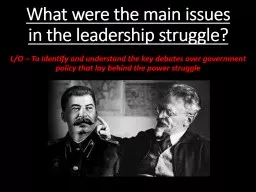

LO To identify and understand the key debates over government policy that lay behind the power struggle Main issues When we study power struggles we often focus on the personalities involved their strengths and weaknesses and ID: 247660
Download Presentation The PPT/PDF document "What were the main issues in the leaders..." is the property of its rightful owner. Permission is granted to download and print the materials on this web site for personal, non-commercial use only, and to display it on your personal computer provided you do not modify the materials and that you retain all copyright notices contained in the materials. By downloading content from our website, you accept the terms of this agreement.
Slide1
What were the main issues in the leadership struggle?
L/O – To identify and understand the key debates over government policy that lay behind the power struggleSlide2
Main issues
When we study power struggles, we often focus on the personalities involved, their strengths and weaknesses, and
why
one emerged stronger than the others.
But we also have to look at the issues that were uppermost in people’s minds when the struggle was taking place. These are just as important in persuading people to support one candidate rather than another.The key issues were to do with: leadership, industrialisation and party policy.Slide3
1. The nature of the leadership
Many party members did not want one person to rule the party. After Lenin, they hoped that ‘collective leadership’ would be a more socialist way of running the state.
Party members feared that a ‘
dictator
’ could emerge to take control of the centralised state that had developed by 1924. Many feared Trotsky! He was commander of the Red Army and could crush opposition. He was also seen as arrogant and had his own ideas about the direction of the party. This confirmed such fears.Slide4Slide5
1. The nature of the leadership
Party members were also worried about the unity of the party after Lenin’s death. They knew the Party had to stick together in order to transform an
unwilling population
into
good socialists.Therefore they did not want a leader who might cause divisions amongst the different wings of the party and split it. Many feared Trotsky would do this!Slide6
2. The NEP and Industrialisation Debate
NEP was the key issue in party conference debates. Everybody agreed on the need to industrialise – it was key to creating a large class of
proletarian workers
to build socialism.
The question was how to do this in the most effective way. Was the NEP the best way?By the mid 1920s, party members were disturbed by the growth of a rich superclass, property dealing, land speculation, gambling and prostitution – all blamed on the NEP.Slide7
Problems with NEP
By 1925-26, industry had recovered to pre-1913 levels. Debate raged on how to improve industry further. Where were the resources
going to come from to do this? No loans available!
High level of unemployment amongst workers
. Wages did not rise in level with rising prices of consumer goods which were in short supply. Workers were poor and no jobs – in the workers’ society!Food shortages started to reappear. Peasants held onto their produce.Slide8
Debate over NEP
All agreed NEP was a short-term, stop-gap measure – but when and how should it be ended?
Left Wing (Left Communists)
= Party members who wanted NEP abandoned. Trotsky, Zinoviev and Kamenev wanted to
militarise workers to achieve rapid, FORCED industrialisation (Maoism?)Right Wing (Right Communists) = Party members who wanted NEP to continue. Bukharin wanted to ENCOURAGE peasants to become richer, spend more on consumer goods which would lead to growth of manufacturing industry. (Capitalism?)Slide9
3. ‘Permanent Revolution’ vs
‘Socialism in One Country’The last issue faced in the 1920s was the overall policy that the party should develop for the future.
The USSR was the
only Communist state
in the world and world revolution had not taken place. Trotsky and Stalin had different ideas on this.Trotsky = believed in permanent world revolution. Without outside support, the revolution in Russia would collapse.Stalin = believed that Party had to concentrate on
building a socialist state in the USSR without the help from other countries.Slide10
Questions
Make notes summarising the key issues facing the party in the 1920s.
Which contender would be most hindered by the leadership issue?
How do you think the divisive NEP debate would affect the chances of particular contenders?
Which policy – ‘Permanent Revolution’ or ‘Socialism in One Country’ – do you think would most appeal to party members after so many years of conflict? Which contender would this help most?